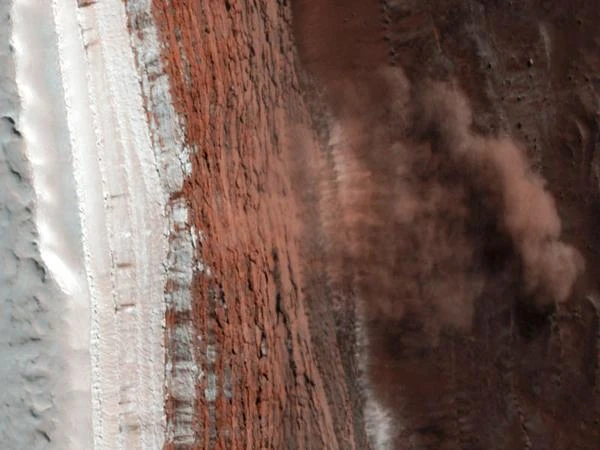
The Mars Reconnaissance Orbiter (MRO) is a versatile orbital platform designed for geophysical, mineralogical, and climatic observation of Mars. Launched on August 12, 2005, and inserted into Martian orbit on March 10, 2006, MRO combines a set of high spatial and spectral resolution instruments with a data relay capability for landers and rovers. Its launch mass is approximately 2,180 kg, and the probe operates from a quasi-circular low orbit (variable slope around ~250–320 km), optimized for the HiRISE camera and the SHARAD radar.
From an orbital perspective, MRO was placed in a low quasi-circular polar orbit to optimize spatial resolution and observation repeatability. The typical nadir altitude for HiRISE is between ~255 and 320 km, resulting in a ground scale close to 0.25–0.32 m/pixel for vertical shots. This scale is a direct result of optical geometry: for a telescope with diameter \(D\) and focal length \(f\), the theoretical angular resolution limited by diffraction follows approximately \(\theta \approx 1.22 \frac{\lambda}{D}\). However, the achieved resolution (~0.3 m/pixel) results from a compromise between optics, attitude stability, observation altitude, and detector size.
HiRISE (High Resolution Imaging Science Experiment) is the flagship instrument of MRO. It is a 0.5 m diameter telescope, focusing light on a 20,000-pixel-wide CCD detector. This configuration allows obtaining images where each pixel covers less than one square meter of the Martian surface. Optical alignment and thermal stability constraints are critical: a shift of a few microradians is enough to degrade image sharpness.
In nearly two decades of observation, MRO has transformed our knowledge of Mars:
| Instrument | Function | Resolution | Spectral Range |
|---|---|---|---|
| HiRISE | High-resolution optical imaging | 0.25–0.32 m/pixel | Visible (~0.4–0.9 µm) |
| CRISM | Mineralogical spectral analysis | 18–36 m/pixel | Visible to near IR (0.36–3.9 µm) |
| SHARAD | Subsurface sounding radar | 15 m vertical / 3000 m horizontal | 15–25 MHz |
Source: NASA Mars Reconnaissance Orbiter and HiRISE University of Arizona.